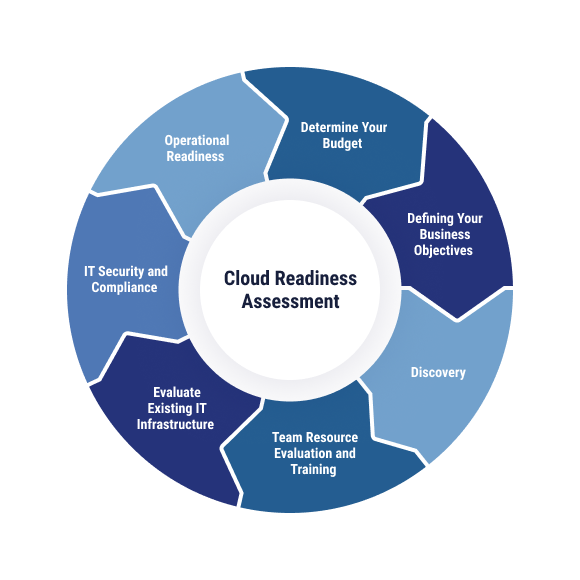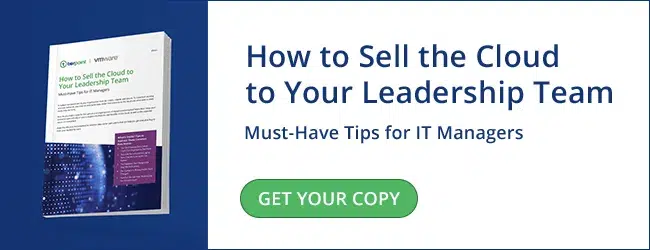
A move to the cloud can come with promises of greater flexibility, ease, scalability, and modernization, but it doesn’t mean the migration process will be a breeze. According to the latest forecast from Gartner, Inc., the worldwide end-user spending on public cloud services will grow by 20.4% to total $678.8 billion in 2024. Migrating to the cloud successfully requires proper planning and analysis before taking that first step. One of the best ways to evaluate your organization’s preparedness is by using a cloud readiness assessment framework. From there, you can build a migration roadmap that doesn’t leave anything to chance.
What is a Cloud Readiness Assessment?
A cloud readiness assessment can help businesses determine whether they’re prepared to move to the cloud by working through a checklist. This cloud readiness assessment checklist should include an examination of what needs to be done (if anything) to the applications and data used by a business to prepare it for cloud migration. It can also help make a plan for migration that causes minimal interruption to “business as usual.”
A thorough cloud readiness assessment checklist will include defining your business objectives, a discovery process, an evaluation of team resources, an understanding of current IT infrastructure, IT security & compliance considerations, operational readiness, and budget considerations.

Defining Your Business Objectives
Before you can define what migration readiness looks like, your organization must ensure the planned migration aligns with the strategic goals within your business objectives. Goals to consider include:
- Agility
- Innovation
- Competitive advantages
- Enhancing the overall customer experience
Discovery
After you define your business objectives, begin a deeper discovery process. During this stage, it’s important to consider costs, cloud scalability, data resiliency, failover, remote collaboration, and so on. Think about the following questions:
- How quickly will you need to be able to expand or contract your cloud environment in the face of fluctuating demand?
- How would you like to insulate your organization from disaster, and what can cloud environments provide that your current infrastructure cannot?
- What would you like to continue in a cloud environment that’s already working with your present setup?
- Do team members need to be able to access certain applications on their mobile devices or other remote sites?
- Starting with stated objectives will ensure your cloud migration strategy doesn’t leave anything important by the wayside.
Starting with stated objectives will ensure your cloud migration strategy doesn’t leave anything important by the wayside.
Team Resource Evaluation and Training
What internal resources are at your disposal? Where might you require additional training or talent? Assessing your internal skill sets, available funds, and unclaimed IT staff time can better illustrate gaps in your knowledge and processes. If you don’t have anyone who’s a cloud migration expert, or you plan on adding tools that no one internally has used, bringing in outside help may be necessary. A third-party provider could do everything from conducting the assessment and planning and implementing the migration to training your team.
Evaluate Existing IT Infrastructure
Chances are, some of your workloads will be easier to move to the cloud than others, and some may not need to move at all. To determine what should make the move, businesses should evaluate by considering the following:
- Workload complexity
- Resource requirements
- Data security needs
- Best cloud fit for each workload (public, private, hybrid)
- App and component dependencies
- Physical appliances needed during migration
A more complex workload with increased dependencies will be more difficult to move than one that is self-contained and easy to translate to a public cloud environment, for example.
You likely also have some workloads that can be eliminated at some point in the migration process. Applying the 7 R’s of cloud migration can categorize the workloads for you – more on that later.
IT Security and Compliance
What should move to the cloud may be partially or completely determined by the security and compliance requirements you have for your data. If you have strict regulatory requirements to meet for some of your data, it may make sense for it to stay in an on-premises framework. Weigh what you might want to do with public and private cloud alongside your compliance needs.
In addition to considering security and compliance requirements when determining what data should move to the cloud, it’s crucial to consider the following potential factors when it comes to migration timing:
- For End-Users: Requirements can encompass factors such as access controls, authentication mechanisms, data privacy considerations, and user training or awareness programs. It’s important to note that these aspects directly impact the security posture of the cloud environment and must be evaluated to ensure compliance with relevant regulations and standards.
- For Customer-End Users: Requirements may involve contractual obligations, service level agreements (SLAs), data handling procedures, and privacy protections.
Addressing these requirements during the cloud readiness assessment ensures that the migration plan aligns with the needs and expectations of end-users and customers, thereby enhancing overall security and compliance readiness. Additionally, by carefully assessing both the technical aspects of security and compliance alongside end-user or customer needs, organizations can strategically plan and execute cloud migrations that prioritize data protection, regulatory adherence, and user satisfaction.
Operational Readiness
This may sound obvious, but a major part of cloud readiness is making sure you’re operationally prepared for a migration. Consider the following questions:
- Are teams ready to shift the way they do things in favor of progress?
- What training might you have to do?
- Do you have maintenance windows or moratoriums on when an outage can occur during migration?
Most cloud migration projects will also come with a significant level of organizational change. By building a clear plan, and communicating that plan to all teams at all levels, you can emphasize the end goal and more deftly navigate through any potential disruptions. Proactively address concerns when you can and identify early champions of your cloud migration efforts – both of these approaches will help improve areas of resistance. Offer training throughout the migration, provide post-migration support, and welcome feedback as a way to iterate and improve.
Determine Your Budget
A gap may exist between what you’d like to accomplish and what you have the resources to achieve, but the only way to know for sure is by budgeting out your migration plans. Whether you’re planning on doing it all at once or in phases, the following questions may help you determine your budgetary needs:
- What’s your desired timeline for completing your cloud migration project?
- Who will be involved in the process?
- Will you need to pay for outside help?
- What’s the cost of any downtime you might experience, even if it’s minimal?
- When you’re making the switch to new software, what’s the cost of licensing?
- How much will cloud providers charge for the resources and services you need?
- What does the total cost of ownership (TCO) look like?
The more you include in your budget scoping, the better you’ll understand the overall cost of the project.
Benefits of Cloud Readiness Assessment
Getting started can be the hardest part of any new project. A cloud readiness assessment is a powerful first step businesses can take before exploring all of what the cloud has to offer. Developing a cloud readiness assessment can help organizations optimize their budgets, identify potential risks, focus on scalability and resource management, and keep security at the forefront.
While businesses have already been increasingly migrating their workloads to the cloud, more is on the way – 44% of respondents to Flexera’s 2023 State of the Cloud say that moving more workloads to the cloud is a top priority for the coming year. As more organizations deploy generative AI services and other, more resource-intensive workloads, they will be looking to public cloud and managed cloud providers to handle these technological advances.
Streamline Cloud Strategy and Migration Budget
Strategic planning as part of a cloud readiness assessment will include the cloud service model that makes the most sense for your business (IaaS, PaaS, or Saas) based on your requirements and your budget. The more you can determine upfront, the less likely you are to encounter surprise expenses.
Mitigate Cloud Migration Risks
It’s easy to think you have a good understanding of all of the steps involved in a cloud migration without having to document them anywhere, but without a readiness assessment, it’s easy for small steps to go unaccounted for. Conducting an intentional analysis enables you to pinpoint specific, sequential steps of the migration, giving you the power to plan with greater accuracy and less risk.
Scalable Infrastructure
Being transparent about your infrastructure’s ability to adapt to future growth and the changing needs of your business in a readiness assessment can help you create new cloud architecture that is more scalable and flexible. Unlike an on-premises environment, the cloud can provision resources and respond to fluctuating demands automatically.
Resource Management
It’s hard to manage what you can’t see. A cloud readiness assessment can illustrate how resources are currently being used across your environment and help you optimize resource allocation, which will in turn reduce costs and make resource use more efficient. So, it’s important to develop a plan for continuous monitoring and optimizing resources post-migration.
Security and Compliance
Some security concerns should be addressed prior to cloud migration, whereas others may need to be implemented post-migration, and a cloud readiness assessment can help you consider needs for both. Outline current security vulnerabilities, determine necessary compliance requirements, and carve out a plan for continuous monitoring in your readiness assessment.
Risks of Not Assessing Your Cloud Readiness
Maybe it feels like you don’t have time for a cloud readiness assessment before it’s time to make a migration. However, rushing into the process can open yourself up to preventable risks.
Excessive Downtime
Moving something without considering important dependencies can lead to unexpected and excessive downtime, decreasing productivity and output that can lead to a loss in revenue and overall trust. Oftentimes, the problem is bigger than the average cost of downtime for an hour or day of being out of commission. Bigger risks come from the ripple effects caused by the downtime itself.
Vendor Lock-in
Making a hasty decision and signing with a vendor before determining whether they’re the right partner for the job can lead to lock-in, either because of a long-term contract or due to sunk costs of migration and configuration.
Compliance Issues
Compliance should always be top-of-mind when choosing a cloud provider. Your industry and level of data sensitivity will determine your compliance requirements. Not exploring this could lead to incompatibility with government mandates.
Inability to Scale With Organizational Growth
If your organizational plan includes growth, you need to have cloud infrastructure that grows with you. Cloud readiness should also include a scope and a vision – where are you now and where do you plan to be in a few years? Can your cloud migration plans get you there?
Strategies for planning and implementing scalable solutions in the cloud need to take into account which resources are scalable already, and what autoscaling services and solutions may need to be brought in. Developing architecture based on microservices can also scale smaller pieces independently. Businesses may also want to look into infrastructure as code (IaC), infrastructure provisioning that can make it easier to scale infrastructure in a consistent, repeatable way.
Cybersecurity Vulnerabilities
The type of cloud service – Software as a Service (SaaS), Infrastructure as a Service (IaaS), or Platform as a Service (PaaS) – will determine what level of security the cloud provider is responsible for maintaining. But don’t forget, security will also be a combined responsibility between you and the cloud provider. Not knowing, or preparing, can lead to serious and costly data breaches and lawsuits.
One of the most important ways to protect workloads before, during, and after a cloud migration is through data backup and recovery. By creating copies of your data and storing it in a location separate from your main site, you greatly improve the ability to recover your data in the event of a disaster. This might look like creating regularly scheduled full backups, updated incremental backups, or continuously capturing your data. Moving to the cloud also provides the perfect opportunity to consider cloud-based backup and recovery services.
Failing to Plan for Complexity
These issues can be complicated in larger organizations that lack a cloud adoption strategy or where a hybrid cloud adoption is already underway. Migrating to multiple cloud providers or to a hybrid on-premises and cloud environment requires interoperability and, often, integration between the different environments.
Cloud Readiness Assessment Tools
Cloud readiness assessment tools serve as useful counterparts to a comprehensive checklist. Some of the tools TierPoint uses with clients to evaluate cloud readiness include:
- Azure Migrate: This tool by Microsoft Azure explores and assesses your on-premises resources and offers an easy interface for end-to-end tracking and insights. It also includes insight into Azure cost optimization opportunities.
- AWS Assessment Tool: AWS offers a prescriptive model that grants insight into where an organization is at in its cloud journey, discovers gaps, and identifies strengths and weaknesses.
- Cloudockit: Cloudockit is a documentation tool that generates technical documentation and architecture diagrams so organizations can better visualize their cloud environments.
Cloud Migration Assessment
Going beyond a cloud readiness assessment, a cloud migration assessment serves as the first step for organizations on their way to cloud migration, and timing is critical. This assessment provides greater detail into determining what should stay, what should move, and how much needs to be changed for each application, which brings us to the 7 R’s.

If done right, a successful cloud migration strategy will abide by the 7 R’s of cloud migration: Refactor, replatform, repurchase, rehost, relocate, retain, and retire.
- Refactor: Refactoring, or re-architecting, involves moving and modifying application architecture in a way that capitalizes on features and abilities that are native to the cloud. Doing this can improve performance, enable scalability, and boost agility.
- Replatform: Replatforming also involves moving an application to the cloud, but the lift in the cloud is less than refactoring – some optimizing will be done but it won’t include a full modification.
- Repurchase: Move from purchasing one tool to another that works better in the cloud.
- Rehost: Without changing anything, move an application to the cloud for the benefits of cloud capabilities.
- Relocate: Infrastructure can be relocated to the cloud without making too many changes, like purchasing new hardware, changing operations, or adapting applications.
- Retain: Some applications may need to stay in their current environment because the refactoring that needs to be done is too burdensome for the time being. There also might not be a good business reason for migrating a legacy application.
- Retire: Applications that are no longer needed in either your current or future environment can be removed, or “retired.”
How TierPoint can help plan your digital transformation
Planning a seamless cloud migration to just one environment can involve a lot of moving parts, and that doesn’t even take into account the complexity that can come with hybrid and multicloud strategies. Managing cloud services and providers holistically, instead of viewing them as stand-alone purchases, is essential. The best way to plan your move to the cloud is with the right cloud assessment tools and cloud partner.
At TierPoint, we can help define a transition plan that will get you on the road to a cloud enabled digital transformation without too many pit stops or potholes along the way. Contact us to learn more or download our Journey to the Cloud eBook for other key components to consider before you begin your cloud migration.

FAQ’s
Performing a cloud readiness assessment is a critical step in the process of migrating to the cloud. As the name suggests, it enables organizations to determine their present level of readiness to migrate their IT systems and data from on-premises to the cloud. It also helps them spot and plan for potential gaps or obstacles they may encounter ahead of time.
There are a number of steps you should list within a cloud readiness assessment checklist, including: understanding and outlining business objectives, a detailed evaluation of existing IT systems, data, and infrastructure, and identifying data and security requirements, among others.
A cloud readiness assessment tool is a software or service that helps automate the assessment process for organizations. It can be helpful to utilize such tools to easily gather and analyze data so organizations can draw better insights on their current infrastructure and their overall readiness for migration.
